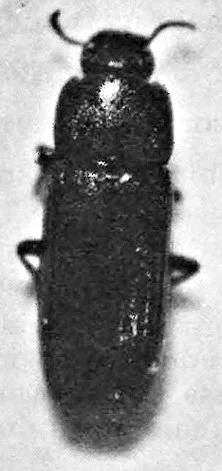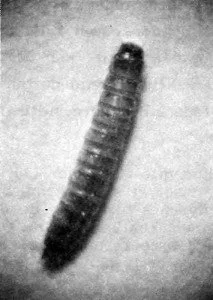
In Germany in 1934 an unknown beetle was found in a shipload violet seeds. It was described to science under the name of Tribolium destructor. It turned out to be a rare African species, native to Ethiopia, which apparently had gone astray. It seems that the Tribolium destructor, the dark flour beetle, never managed to establish itself in Germany, and in several of the otherwise comprehensive books on German pests is was not even mentioned. In Sweden the dark flour beetle appears in 1936 in a shipload of birdseeds, which was mixed with corn, supplied from Germany. In the period up to 1943 the presence of the dark flour beetle is documented in fifty cases, and since then it has been a well-established synanthrope in Sweden.
In 1943 the first case of Danish dark flour beetles in a private home is reported, but it was not until 13 years later that the beetles began to appear regularly in kitchens and larders in that country. In 1956 in a flat that was filled with caged birds, a large amount dark flour beetles lived in the floor cracks. From here the dark flour beetle spread to other flats in the same property. In the flat downstairs residents would collect fifty beetles a day. Evidence suggests that the dark flour beetle was helped establish themselves in Denmark by being spread alongside with packs of birdseed. It is known that a bird feed wholesaler in the period 1954 – 1958 had a storage room which was massively infested by the beetle. It could be descendants of these beetles that are still found in Denmark today.
In England the dark flour beetle has not yet emerged as a real pest. Individual findings of the beetle in London storages were recorded in 1962-1965. The pests were found on or in poisoned rodent traps. Visits to the company that had supplied the oatmeal to the traps gave no result at first. Seven years later the beetle was found in the company’s premises which after British pest laboratory’s estimates came from the originally infected oatmeal.

The dark flour beetle is now a common food pest in Denmark, Norway, Finland and Sweden, but is virtually unknown in most other countries. In Canada, Germany and the former Soviet Union, it is occasionally found in houses and storages, but regarded as a rare and relatively harmless species. British researchers suggest that the relatively high indoor temperatures in Denmark – not below 20 ° C in winter – can be one of the explanations to the dark flour beetle’s Scandinavian dissemination. The beetle does not develop at temperatures lower than 15-17 °C and it has its shortest development time at 30 ° C. The dark flour beetle lives like the yellow mealworm beetle and it is also similar to this in appearance. The mealworm beetle often lives in birds’ nests and the dark flour beetle has an appetite for birds’ feed, and the temperatures in the indoor bird cages. Oddly enough the dark flour beetle is uncommon in international trade. The British import statistics, as already mentioned a few times, include long lists of species of beetles that have been seen in over 100,000 shiploads exported to British ports. The list drawn up by the beetle experts did not mention the dark flour beetle even once!




